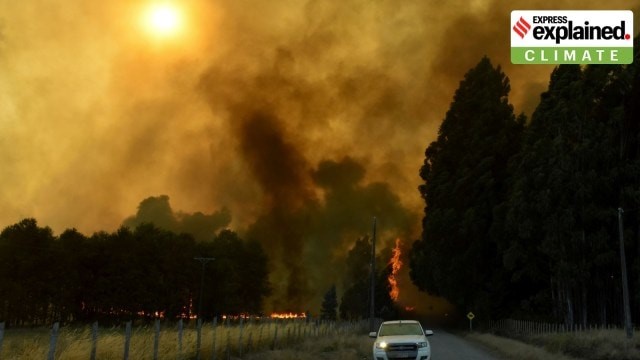La Niña 2024–25

- 15 Feb 2025
In News:
Despite the expected cooling influence of La Niña, January 2025 became the hottest January on record, with global average surface air temperatures 1.75°C above pre-industrial levels (1850–1900), according to the Copernicus Climate Change Service (C3S). This marked the 18th out of the last 19 months that global temperatures exceeded the 1.5°C threshold. The inability of La Niña to curb this warming trend underscores the intensifying impact of anthropogenic climate change.
Understanding La Niña and the ENSO Cycle
La Niña, meaning "The Little Girl" in Spanish, is the cool phase of the El Niño Southern Oscillation (ENSO)—a recurring climate phenomenon involving variations in oceanic and atmospheric conditions in the central and eastern tropical Pacific Ocean.
- Phases of ENSO:
- El Niño (warm phase): Warmer ocean temperatures in the eastern Pacific, weakening trade winds and reducing rainfall in the western Pacific.
- La Niña (cool phase): Colder sea surface temperatures in the eastern Pacific, strengthening trade winds and enhancing rainfall in the western Pacific.
- Neutral phase: Sea surface temperatures are near average with no dominant anomalies.
- Mechanism: During La Niña, strengthened trade winds push warm surface waters westward, causing cold waters to upwell in the eastern Pacific. This typically results in global cooling.
- ENSO Cycle: These phases occur every 2 to 7 years and influence weather patterns globally. The ENSO cycle leads to sea surface temperature variations between ±1°C to ±3°C from the long-term average.
The 2024–25 La Niña: A Weakened Climate Driver
- Emergence: The current La Niña phase began in December 2024, later than anticipated. Forecasts had expected it around September 2024, giving it insufficient time to strengthen before its typical peak in the Northern Hemisphere winter.
- Intensity: It is projected to be a mild La Niña, reducing its capacity to significantly influence global temperatures.
- Past Events: The most recent La Niña cycle lasted from 2020 to 2023, followed by a strong El Niño through mid-2023.
- Delayed Cooling Effect: The weaker-than-usual La Niña failed to produce the anticipated cooling, surprising scientists. As Julien Nicolas from Copernicus observed, the expected “temporary brake” on global temperatures did not materialize.
Why January 2025 Remained Hot Despite La Niña
- Global Ocean Warming: Oceans have retained higher-than-usual warmth due to long-term climate change, diluting La Niña’s cooling influence.
- Weak La Niña Onset: A late and weak phase meant less disruption to the prevailing warming trend. According to NOAA, La Niña events need more time and intensity to impact temperatures effectively.
- Persistent GHG Emissions: The concentration of greenhouse gases reached record highs in 2024, adding to the Earth's heat burden. Typically, La Niña-induced rains spur vegetation growth and carbon absorption, but weaker rains in this cycle limited that effect.
- Reduced Aerosols: Declines in atmospheric aerosols—due to cleaner air policies—lessened their usual cooling impact. Aerosols scatter solar radiation and influence cloud dynamics, contributing to temperature moderation.
Global and Regional Climatic Impacts of La Niña
Despite its weak intensity, La Niña still shaped regional weather in varied ways:
Asia
- India: Higher monsoon rainfall (July–September) is expected. This boosts rice production but may reduce pulse output in the Indo-Gangetic Plain.
- Southeast Asia: Nations like Indonesia, Malaysia, and the Philippines face increased rainfall—raising flood risks but aiding rice and palm oil yields.
South America
- Southern Brazil, Uruguay, northern Argentina, and southern Bolivia face drought due to reduced rainfall, affecting soybean and maize crops.
- Northern Brazil, Colombia, Venezuela, and parts of Ecuador and Peru receive excess rain, risking floods.
Africa
- East Africa: Experiences dry conditions in December–January, hampering harvests in February–March.
- Southern Africa: Receives above-average rainfall, benefitting crops like maize, wheat, sorghum, and soybeans.
Oceania
- Australia: Faces heavy rain and possible flooding in its northern and eastern regions.
North America
- Southern US: Experiences dry conditions.
- Northern US, Canada, and Alaska face wetter, stormier weather.
Significance for India
- Agriculture: Enhanced monsoon rains improve farm productivity, especially rice.
- Water Resources: Better reservoir levels alleviate water stress.
- Energy: Increases hydropower potential.
- Heat Mitigation: Reduces severity of heatwaves compared to El Niño years.
Monitoring & Prediction
- Oceanic Niño Index (ONI): Tracks 3-month average SST anomalies. Values below –0.5°C indicate La Niña.
- Nino-3.4 Index: Confirms ENSO thresholds. Anomalies of ±0.5°C signal event onset; ±1.5°C indicates strong events.
- Tools Used: Satellite data, trade wind strength, and ocean buoys support forecasts. La Niña can be predicted up to two years in advance if preceded by a strong El Niño.
Conclusion:
The 2024–25 La Niña's inability to cool global temperatures highlights a worrisome trend—the diminishing moderating influence of natural climate phenomena. With greenhouse gas emissions continuing to rise and natural cooling cycles weakening, urgent global action is needed to reduce emissions and mitigate climate change impacts.
